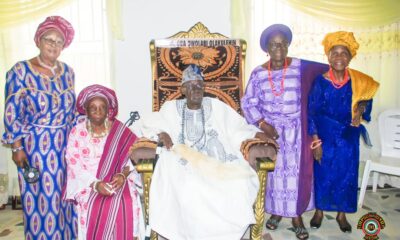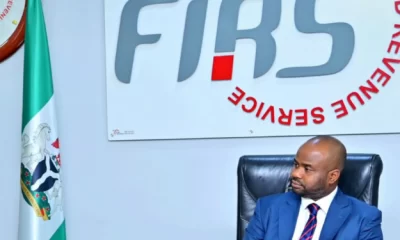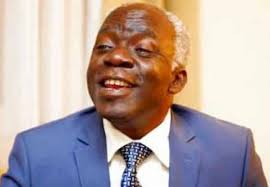Top Stories
Queen Elizabeth II: A long reign marked by a high sense of duty and dignity
Queen Elizabeth II Biography, Age, Children, Wealth, Reign and cause of death can be accessed below.
TRENDING: Queen Elizabeth Is Dead
Queen Elizabeth II died at the age of 96 years and Queen Elizabeth II death was announced by Buckingham Palace.
How Queen Elizabeth Died, The Royal Family Account
The Prince of Wales, the Queen’s eldest son, has become the new monarch, King Charles III. Buckingham Palace said in a statement: “The Queen died peacefully at Balmoral this afternoon.
This online newspaper understands that Britain was in mourning after her death, which marks a watershed moment in the life of the nation, ending a reign that spanned 70 years.
The King and The Queen Consort will remain at Balmoral this evening and will return to London tomorrow.” Senior members of the royal family had travelled earlier in the day to be with her at Balmoral, the Queen’s castle in the Scottish highlands, while at Westminster the mood among senior politicians was sombre.
The Queen celebrated the 70th anniversary of her reign this year. She had represented continuity and stability for Britain from the postwar era into the 21st century.
The country was braced for the death of the monarch on Thursday morning when Buckingham Palace issued a rare medical bulletin on the Queen’s health. The BBC suspended normal programming. Earlier this week, the Queen, who had suffered from mobility issues for some time, oversaw the transition of power from Boris Johnson to new prime minister Liz Truss from Balmoral instead of travelling to London.
The news of the monarch’s condition was relayed to Truss in the House of Commons shortly before midday, as she made a statement to parliament on a state intervention in the energy market. The Queen had been a central part of life in the UK for seven decades, since the death of her father George VI in 1952.
She took the throne when Winston Churchill was in Downing Street and this week invited Truss, the 15th prime minister of her reign, to form a new government. Her reign encompassed the decolonisation of much of the British empire in Africa and Asia, as well as the consolidation of the Commonwealth.
It also saw the emergence of the modern monarchy, which became the subject of intense media scrutiny. The Queen’s personal popularity was seen as a key factor in maintaining support for the monarchy in the UK in recent years. She shied away from political interventions and was known chiefly to her subjects by her presence at public events and televised Christmas messages, which often emphasised the values of duty and dialogue.
She became the longest-serving monarch in British history in 2015, surpassing her great-great-grandmother Queen Victoria.
Who Was Queen Elizabeth II?
Queen Elizabeth II became queen on February 6, 1952, and was crowned on June 2, 1953. She was the mother of Prince Charles, heir to the throne, as well as the grandmother of Princes William and Harry. As the longest-serving monarch in British history, she tried to make her reign more modern and sensitive to a changing public while maintaining traditions associated with the crown.
Queen Elizabeth II Early Life
Queen Elizabeth II was born Princess Elizabeth Alexandra Mary on April 21, 1926, in London, to Prince Albert, Duke of York (later known as King George VI), and Elizabeth Bowes-Lyon.
At the time of her birth, most people did not realize Elizabeth would someday become the queen of Great Britain. Elizabeth, nicknamed Lilibet, got to enjoy the first decade of her life with all the privileges of being a royal without the pressures of being the heir apparent.
Elizabeth’s father and mother divided their time between a home in London and Royal Lodge, the family’s home on the grounds of Windsor Great Park. Elizabeth and her younger sister Margaret were educated at home by tutors. Academic courses included French, mathematics and history, along with dancing, singing and art lessons.
With the outbreak of World War II in 1939, Elizabeth and her sister largely stayed out of London, having been relocated to Windsor Castle. From there she made the first of her famous radio broadcasts in 1940, with this particular speech reassuring the children of Britain who had been evacuated from their homes and families. The 14-year-old princess, showing her calm and firm personality, told them “that in the end, all will be well; for God will care for us and give us victory and peace.”
Elizabeth soon started taking on other public duties. Appointed colonel-in-chief of the Grenadier Guards by her father, Elizabeth made her first public appearance inspecting the troops in 1942. She also began to accompany her parents on official visits within Britain.
In 1945, Elizabeth joined the Auxiliary Territorial Service to help in the war effort. She trained side-by-side with other British women to be an expert driver and mechanic. While her volunteer work only lasted a few months, it offered Elizabeth a glimpse into a different, non-royal world. She had another vivid experience outside of the monarchy when she and Margaret were allowed to mingle anonymously among the citizenry on Victory in Europe Day.
Ascension to the Crown
When Elizabeth’s grandfather George V died in 1936, his eldest son (Elizabeth’s uncle) became King Edward VIII. Edward, however, was in love with American divorcée Wallis Simpson and had to choose between the crown and his heart. In the end, Edward chose Simpson and abdicated the crown.
The event changed the course of her life, making her the heir presumptive to the British crown. Her father has crowned King George VI in 1937, taking on the name George to emphasize continuity with his father. Her mother became Queen Elizabeth; on King George’s death in 1952, she became Queen Mother and her daughter became Queen Elizabeth II.
Queen Elizabeth II Coronation
Elizabeth was crowned Queen Elizabeth II on June 2, 1953, in Westminster Abbey, at the age of 25.
Elizabeth assumed the responsibilities of the ruling monarch on February 6, 1952, when her father, King George VI, died. For the first time ever, the coronation ceremony was broadcast on television, allowing people from across the globe to witness the pomp and spectacle of the event.
Queen Elizabeth II Husband, Prince Philip
Elizabeth married her distant cousin Philip Mountbatten (a surname adopted from his mother’s side) on November 20, 1947, at London’s Westminster Abbey.
Elizabeth first met Philip, son of Prince Andrew of Greece, when she was only 13. She was smitten with him from the start. The two kept in touch over the years and eventually fell in love.
They made an unusual pair. Elizabeth was quiet and reserved while Philip was boisterous and outspoken. Her father, King George VI, was hesitant about the match because, while Mountbatten had ties to both the Danish and Greek royal families, he didn’t possess great wealth and was considered by some to have a rough personality.
At the time of their wedding, Great Britain was still recovering from the ravages of World War II, and Elizabeth collected clothing coupons to get fabric for her gown.
The family took on the name Windsor, a move pushed by her mother and Prime Minister Winston Churchill which caused tension with her husband. In 1960, she reversed course, issuing orders that her descendants who did not carry royal titles (or needed last names for legal purposes such as weddings) would use the surname Mountbatten-Windsor. Over the years, Philip inspired numerous public relations headaches with his off-the-cuff, controversial comments and rumors of possible infidelities.
Philip died on April 9, 2021, at age 99.
Queen Elizabeth II Children
Elizabeth and Philip wasted no time in producing an heir: Son Charles was born in 1948, the year after their wedding, and daughter Anne arrived in 1950. Elizabeth had two more children—sons Andrew and Edward—in 1960 and 1964, respectively.
In 1969, she officially made Charles her successor by granting him the title of Prince of Wales. Hundreds of millions of people tuned in to see the ceremony on television.
In 1981 32-year-old Charles wed 19-year-old Diana Spencer (best known as Princess Diana), with later rumors surfacing that he was pressured into the marriage by his family. The wedding drew enormous crowds in the streets of London and millions watched the proceedings on television. Public op inion of the monarchy was especially strong at that time.
Grandchildren and Great-Grandchildren
Charles and Diana gave birth to Elizabeth’s grandsons Prince William, who was created Duke of Cambridge upon his own marriage in 2011, second-in-line to the throne, in 1982, and Prince Harry in 1984. Elizabeth has emerged as a devoted grandmother to William and Harry. Prince William has said that she offered invaluable support and guidance as he and Kate Middleton planned their 2011 wedding.
On July 22, 2013, Elizabeth’s grandson William and his wife Catherine, the Duchess of Cambridge, welcomed their first child, George Alexander Louis—a successor to the throne known officially as “His Royal Highness Prince George of Cambridge.”
On May 2, 2015, William and Kate welcomed their second child, Princess Charlotte Elizabeth Diana, the queen’s fifth great-grandchild. On April 23, 2018, they followed with their third child, Prince Louis Arthur Charles.
On May 6, 2019, Prince Harry, Duke of Sussex and his wife, Meghan Markle, gave the queen another great-grandchild with the birth of their son, Archie Harrison Mountbatten-Windsor.
In addition to Prince William and Prince Harry, the queen’s other grandchildren are Peter Phillips, Princess Beatrice of York; Princess Eugenie of York; Zara Tindall; Lady Louise Windsor; and James, Viscount Severn. She was also a great-grandmother to 10.
Queen Elizabeth II Family Tree
Elizabeth II’s father and mother were known as the Duke and Duchess of York. Her father, Prince Albert, Duke of York, was the second son of Queen Mary and King George V. Her mother was Lady Elizabeth Bowes-Lyon.
Elizabeth had ties with most of the monarchs in Europe. Her British ancestors include Queen Victoria (ruled 1837 to 1901) and King George III (ruled 1760 to 1820).
Queen Elizabeth II Reign
Elizabeth’s long and mainly peaceful reign was marked by vast changes in her people’s lives, in her country’s power, how Britain is viewed abroad and how the monarchy is regarded and portrayed. As a constitutional monarch, Elizabeth did not weigh in on political matters, nor did she reveal her political views. However, she confers regularly with her prime ministers.
When Elizabeth became queen, post-war Britain still had a substantial empire, dominions and dependencies. However, during the 1950s and 1960s, many of these possessions achieved independence and the British Empire evolved into the Commonwealth of Nations. Elizabeth II thus made visits to other countries as head of the Commonwealth and a representative of Britain, including a groundbreaking trip to Germany in 1965. She became the first British monarch to make a state visit there in more than five decades.
During the 1970s and 1980s, Elizabeth continued to travel extensively. In 1973 she attended the Commonwealth Conference in Ottawa, Canada, and in 1976 traveled to the United States for the 200th-anniversary celebration of America’s independence from Britain. More than a week later she was in Montreal, Canada, to open the Summer Olympics. In 1979, she traveled to Kuwait, Bahrain, Saudi Arabia, Qatar, the United Arab Emirates and Oman, which garnered international attention and widespread respect.
In 1982, Elizabeth worried about her second son, Prince Andrew, who served as a helicopter pilot in the British Royal Navy during the Falklands War. Britain went to war with Argentina over the Falkland Islands, a clash that lasted for several weeks. While more than 250 British soldiers died in the conflict, Prince Andrew returned home safe and well, much to his mother’s relief.
In 2011, Elizabeth showed that the crown still had symbolic and diplomatic power when she became the first British monarch to visit the Republic of Ireland since 1911 (when all of Ireland was still part of the United Kingdom).
As queen, Elizabeth modernized the monarchy, dropping some of its formalities and making certain sites and treasures more accessible to the public. As Britain and other nations struggled financially, Britain abolished the Civil List in 2012, which was a public funding system of the monarchy dating back roughly 250 years. The royal family continues to receive some government support, but the queen cut back on spending.
Despite the occasional call to step aside for Charles, Elizabeth remained steadfast in her royal obligations as she passed her 90th birthday. She continued making more than 400 engagements per year, maintaining her support of hundreds of charitable organizations and programs.
However, in late 2017 the monarchy took what was considered a major step toward transitioning to the next generation: On November 12, Charles handled the traditional Remembrance Sunday duty of placing a wreath at the Cenotaph war memorial, as the queen watched from a nearby balcony.
In August 2019, Elizabeth made a rare intrusion into political matters when she agreed to a request by Prime Minister Boris Johnson to prorogue (suspend) Parliament until October 14, less than three weeks before Britain’s planned departure from the European Union.
Relationship With Prime Ministers
Elizabeth had 15 prime ministers placed into power during her reign, with queen and PM having a weekly, confidential meeting. (Elizabeth also met about a quarter of all the U.S. presidents in history, most recently receiving Donald Trump for a state visit in June 2019.)
She enjoyed a father-figure relationship with the iconic Winston Churchill and was later able to loosen up a bit and be somewhat informal with Labour leaders Harold Wilson and James Callaghan. In contrast, she and Margaret Thatcher had a very formal, distant relationship, with the PM tending to be a grating lecturer to the queen on a variety of issues.
Tony Blair saw certain concepts around the monarchy as somewhat outdated, though he did appreciate Elizabeth making a public statement after the death of Diana.
Later, Conservative leader David Cameron, who is Elizabeth’s fifth cousin removed, enjoyed a warm rapport with the queen. He apologized in 2014 for revealing in a conversation that she was against the Scottish referendum to seek independence from Great Britain.
Theresa May was described as being tight-lipped about Brexit plans to leave the European Union, with a rumor circulating that Elizabeth was perturbed over not being informed about future exit strategies.
Threats to Queen Elizabeth and the Royal Family
Elizabeth worked tirelessly to protect the image of the monarchy and to prepare for its future. But she saw the monarchy come under attack during her lifetime. The once-revered institution weathered a number of storms, including death threats against the royal family.
In 1979, Elizabeth suffered a significant personal loss when Lord Mountbatten, her husband’s uncle, died in a terrorist bombing. Mountbatten and several members of his family were aboard his boat on August 27th, off the west coast of Ireland, when the vessel exploded. He and three others, including one of his grandsons, were killed. The IRA (Irish Republican Army), which opposed British rule in Northern Ireland, took responsibility for the attack.
In June 1981, Elizabeth herself had a dangerous encounter. She was riding in the Trooping the Colour, a special military parade to celebrate her official birthday when a man in the crowd pointed a gun at her. He fired, but, fortunately, the gun was loaded with blanks. Other than receiving a good scare, the queen was not hurt.
Elizabeth had an even closer call the following year when an intruder broke into Buckingham Palace and confronted her in her bedroom. When the press got wind of the fact that Prince Philip was nowhere to be seen during this incident, they speculated about the state of the royal marriage.
Tabloid Scandals
The marriage of Elizabeth’s son, Charles, to Diana made headlines for years before the couple announced their separation in 1992, followed by their formal divorce in 1996. In the wake of Diana’s death in a Paris car crash on August 31, 1997, Elizabeth experienced intense media scrutiny. Her incredibly popular ex-daughter-in-law had been called the “People’s Princess.”
The queen was at her Balmoral estate in Scotland with Charles and his and Diana’s two sons, Prince William and Prince Harry, at the time. For days, Elizabeth remained silent while the country mourned Diana’s passing, and she was sharply criticized for her lack of response.
Stories circulated that the queen did not want to give Diana a royal funeral, which only fueled public sentiment against the monarch. Nearly a week after Diana’s death, Elizabeth returned to London and issued a statement on the late princess.
Elizabeth also initially objected to the relationship between her son Charles and Camilla Parker Bowles. Charles and Camilla had dated years before he met his family, but the relationship ended under family pressure, only to resume during Charles and Diana’s marriage. Known to be a stickler for ceremony and tradition, she eventually showed signs of softening her stance over the years. When Charles and Camilla wed in 2005, Elizabeth and Prince Philip did not attend the civil ceremony but attended a religious blessing and held a reception in their honor at Windsor Castle.
In 1992, another of Elizabeth’s children, Prince Andrew, ended up in the tabloids, after photos emerged of his wife Sarah Ferguson and another man engaged in romantic activity. The couple divorced soon after.
In November 2017, the media reported the queen had some $13 million invested in offshore accounts. The news came following the leak of the so-called “Paradise Papers” to a German newspaper, which shared the documents with the International Consortium of Investigative Journalists.
The Duchy of Lancaster, which holds assets for the queen, confirmed that some of its investments were overseas accounts, but insisted they were all legitimate.
Also in 2017, the former owner of the lingerie company Rigby & Peller, which had serviced Elizabeth for more than 50 years, wrote a tell-all autobiography that included some of her experiences with the royal family. Although the author insisted that “the book doesn’t contain anything naughty,” the queen responded in early 2018 by revoking Rigby & Peller’s royal warrant.
In 2019, following years of scandal surrounding his controversial business pursuits and friendship with convicted sex offender Jeffrey Epstein, Prince Andrew was forced to step down from public duties, following a media firestorm.
Just weeks later, in January 2020, the family again found themselves in the spotlight, following the bombshell decision by the Duke and Duchess of Sussex to step away from their roles as senior royals.
Personal Losses
After the start of the 21st century, Elizabeth experienced two great losses. She said goodbye to both her sister Margaret and her mother in 2002, the same year she celebrated her Golden Jubilee or 50th year on the throne.
Margaret, known for being more of an adventurous soul than other royals and who was barred from marrying an early love, died in February after suffering a stroke. Only a few weeks later, Elizabeth’s mother, known as the Queen Mother, died at Royal Lodge on March 30th at the age of 101.
Queen Elizabeth II Diamond Jubilee
Elizabeth celebrated her Diamond Jubilee in 2012, marking 60 years as queen. As part of the jubilee festivities, a special BBC concert was held on June 4th featuring the likes of Shirley Bassey, Paul McCartney, Tom Jones, Stevie Wonder and Kylie Minogue. Elizabeth was surrounded by family at this historic event, including her husband Philip, son Charles and grandsons Harry and William.
On September 9, 2015, she surpassed her great-great-grandmother Queen Victoria as Britain’s longest-ruling monarch, who reigned for 63 years.
Queen Elizabeth II Sapphire Jubilee
On February 6, 2017, the queen celebrated 65 years on the throne, the only British monarch to ever celebrate her Sapphire Jubilee. The date also marks the anniversary of the death of her father. The queen chose to spend the day quietly at Sandringham, her country estate north of London, where she attended a church service.
In London, there were royal gun salutes at Green Park and at the Tower of London to mark the occasion. The Royal Mint also issued eight new commemorative coins in honor of the queen’s Sapphire Jubilee.
Queen Elizabeth II Platinum Jubilee
In 2022, the nation celebrated Elizabeth’s platinum jubilee year. She was the first British monarch to reach that milestone, which marks 70 years on the throne.
Elizabeth died peacefully at her Balmoral estate on September 8, 2022. She was 96 years old.
Queen Elizabeth II Hobbies
For much of her life, the queen surrounded herself with dogs. She was especially known for her love of corgis, owning more than 30 descendants of the first corgi she received as a teenager, until the death of the final one, Willow, in 2018.
Elizabeth was also a horse enthusiast who bred thoroughbreds and attended racing events for many years.
Not one for the spotlight, Elizabeth liked quiet pastimes. She enjoyed reading mysteries, working on crossword puzzles and, reportedly, even watching wrestling on television.

- News17 hours ago
Governor Ododo Helps Bello Out Of Abuja Residence Amid EFCC, DSS siege

 News4 hours ago
News4 hours agoIyalode Line Visits Olubadan Designate

 Top Stories5 hours ago
Top Stories5 hours agoWe will no longer allow obstruction of our operations after Ododo interfered in Yahaya Bello’s attempted arrest – EFCC

 Top Stories17 hours ago
Top Stories17 hours agoBreaking: Another Court grants EFCC’s Request To Arrest Ex-Kogi Governor, Yahaya Bello

 Politics4 hours ago
Politics4 hours agoFIRS Chairman Releases Statement As Tinubu Inaugurates National Single Window Committee

 News2 hours ago
News2 hours agoBlack Market Dollar (USD) To Naira (NGN) Exchange Rate Today 18th April 2024

 Top Stories5 hours ago
Top Stories5 hours agoEFCC: Why Yahaya Bello Can’t Evade Arrest, Prosecution — Falana

 Entertainment5 hours ago
Entertainment5 hours agoBobrisky Reportedly Moved From Ikoyi To Kirkiri Prison









